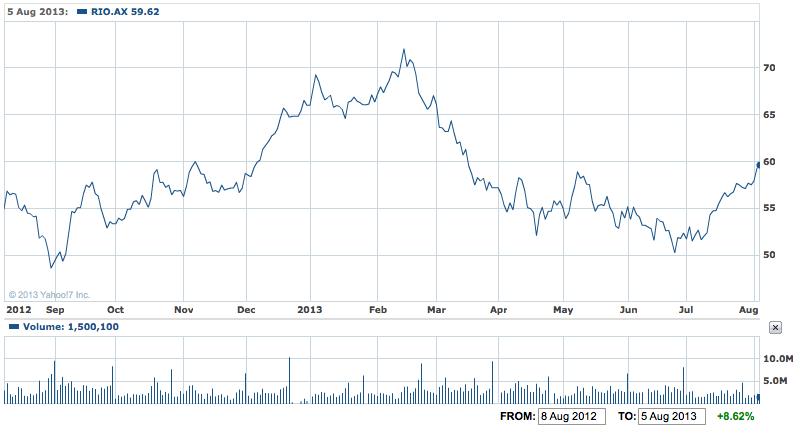Another messy result from Rio Tinto for the six months to June 30, with more write-offs which reduced the already weak pre-tax earnings figures; a decision to abandon trying to sell its weakest aluminium assets; with the only good news, another lift in dividend to keep shareholders happy.
All in all it will be very hard for Rio management to claim that this is anything but yet another update from a company in transition.
Its iron ore business was again the saviour as exports from Australia hit a new record; copper was impacted by lower prices; the cave-in at its huge Bingham Canyon mine in the US; aluminium earned barely nothing on over $US5 billions of revenue and coal was weak.
But interim dividend was boosted 15% to 83 USc (93 Australian cents) from 72.50 USc (68.51 Australian cents).
That followed a similar increase for the final dividend for 2012 and a 15% overall rise for 2012 as a whole.
The company told the ASX and markets offshore late yesterday that underlying earnings fell to $US4.23 billion in the six months to June from $US5.15 billion a year.
Thanks to a stack of write-downs and losses, net profit for the first half plunged 71% to $US1.72 billion ($A1.92 billion, a year ago with the Aussie dollar above parity the result would have been under $A1.7 billion).
The difference between profit and underlying earnings stems from $US2.5 billion in one-off costs. Rio took total write-offs in 2012 of $US14.2 billion, mostly on its weak aluminium businesses, but $US3 billion was on its Mozambique coking coal play which cost $US4 billion originally.
The latest write offs included $US1.9 billion in exchange losses on debt and derivatives, and $US340 million related to the cost of the pit wall slide at the Bingham Canyon copper mine in the US.
No wonder Rio’s shares have fallen 11% this year, badly under-performing an 8% plus rise in the overall market.
The shares rose 88c to 1.5% to $59.48, boosted by the reasonable Chinese trade data for July. The interim result was issued well after the market closed in Australia.
RIO 1Y – Softer commodity prices hit Rio Tinto profits

From the markets point of view, the disappointment was the decision to abandon (for now) the disposal of its Pacific Aluminium business.
Rio put Pacific Aluminium – which houses five aluminium smelters, a bauxite mine and alumina refinery in Australia and New Zealand – on the block in 2011, but failed to find a buyer, even from China. It has decided not to pursue a spin-off to shareholders.
"Following a comprehensive review we have also determined that the divestment of Pacific Aluminium for value is not possible in the current environment and it will be reintegrated into the Rio Tinto Alcan group," chief executive Sam Walsh said in a statement.
That means the company will be stuck with the under-performing assets in a sector that globally remains heavily oversupplied. Shareholders wouldn’t touch these assets.
So no split and following the likes of Amcor or the Murdoch empire into hiving off a large part of the company to angle management to concentrate on the bits with the better prospects (iron ore and copper in the case of Rio).
The ghosts of the very expensive Alcan takeover back in 2007 just before the financial crisis erupted (cost $44 billion in assets and debt) continues to haunt Rio. So far an estimated $US30 billion has been written-off the value of those assets since 2008.
Mr Walsh said in yesterday’s statement: “We are seeing good early results of our business performance initiatives in our pursuit of greater value for shareholders. We have achieved $1.5 billion in total cost reduction efforts in the first half, with $977 million from operating cost savings and $483 million from lower exploration and evaluation spend.
"This has driven strong operating cash flows, on a par with the first half of 2012, despite the weaker prices for most of our products. Capital expenditure has been reduced, approved growth projects are on track and operations are performing well. We have set ourselves firmly on the path toward becoming a leaner, more tightly-run business.
“Across the group, we are focused on improving performance at every location. Our cost saving programme is gathering momentum and we have more than 1,500 separate initiatives that are helping us reduce costs and preserve margins, even in a climate of lower prices. We have driven down our unit costs by more than nine per cent compared with the first half of 2012.
“The medium-term economic outlook remains volatile with a broader range of outcomes now possible. Chinese economic growth has decelerated so far this year and is unlikely to recover significantly in the second half, but we do not expect a hard landing."













